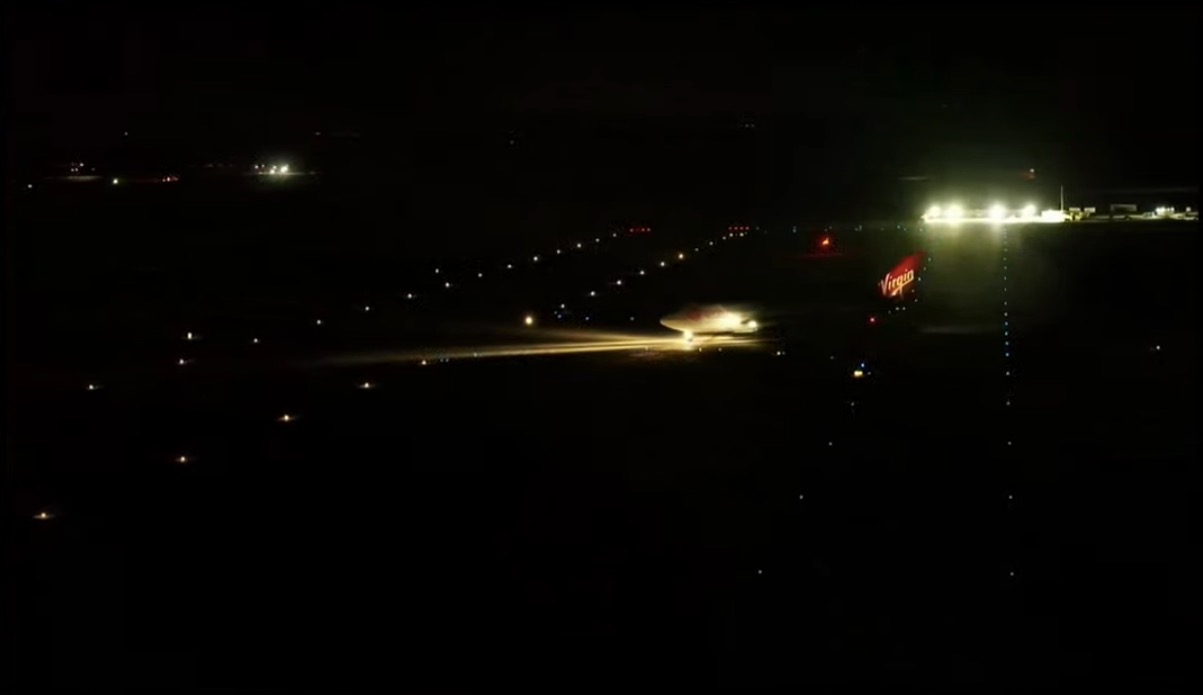Virgin Orbit just aced its fourth mission in a row, launching seven small satellites in the company's first-ever night flight.
Virgin Orbit's carrier plane, a modified Boeing 747 called Cosmic Girl, lifted off from the Mojave Air and Space Port in Southern California on Saturday (July 2) at 1:49 a.m. EDT (0549 GMT; 10:49 p.m. local time) with the company's LauncherOne rocket tucked under one wing.
Cosmic Girl headed west and then southwest, eventually reaching a targeted zone west of the Channel Islands. The plane dropped LauncherOne at 2:53 a.m. EDT (0653 GMT), at an altitude of about 35,000 feet (10,700 meters). A few seconds later, the 70-foot-long (21 m) rocket fired up its first-stage NewtonThree engine, beginning to power its way to orbit.
In photos: Virgin Orbit's LauncherOne rocket for satellite missions

And there we have it, folks! We've just heard from Mission Control that *ahem* NewtonFour successfully reignited and deployed all customer spacecraft into their target orbit. 👏July 2, 2022
That burn lasted three minutes. Shortly thereafter, the rocket's two stages separated, and the upper stage's NewtonFour engine lit up. The NewtonFour blazed for a total of six minutes over two separate burns, taking the seven payloads to their desired orbit, a circular path 310 miles (500 kilometers) above Earth. All seven satellites were successfully deployed there as planned, Virgin Orbit representatives said via Twitter at 3:56 a.m. EDT (0756 GMT).
It was the fourth consecutive successful launch for Virgin Orbit, following satellite-lofting missions in January 2021, June 2021 and January of this year. The company has attempted five launches in total; its first effort, a May 2020 test flight, ended in failure.
Saturday's mission was the first night launch for Virgin Orbit, which is part of Richard Branson's Virgin Group. The company didn't have to operate in darkness this time around but wanted to get some experience doing so.
Get the Space.com Newsletter
Breaking space news, the latest updates on rocket launches, skywatching events and more!
Virgin Orbit was interested in "expanding the envelope and just going to the ops for nighttime missions, because we have some of those on our books that are required," CEO Dan Hart said in a prelaunch call with reporters on Tuesday (June 28). "We want to make sure we do them first in our backyard here in Mojave."
All five of Virgin Orbit's liftoffs to date have originated from the Mojave Air and Space Port, but, as that comment suggests, the company plans to start launching from other locales soon. Indeed, Virgin Orbit is gearing up for a launch from Spaceport Cornwall in England. That mission, which will be the first-ever orbital effort from the United Kingdom, is on track to lift off in September or thereabouts, Hart said.
The seven satellites that went up on Saturday morning were a diverse lot. One of them, the shoebox-sized Adler-1, will study the space debris environment to help improve researchers' models. This little satellite will be operated by Virginia-based company Spire Global.
The Polish company SatRevolution provided two spacecraft, called Stork-3 and SteamSat-2. Stork-3 will join SatRevolution's Stork constellation of Earth-imaging satellites, while SteamSat-2 will test water-fueled thrusters developed by the U.K. company SteamJet Space Systems.
Two other spacecraft are tiny cubesats manifested via NASA's Educational Launch of Nanosatellites program, or ELaNa. One was developed by NASA's Langley Research Center in Virginia and the other by researchers at the University of Colorado, Boulder.
The final payloads that flew on Saturday were research and development satellites sponsored by the U.S. Department of Defense. They will conduct experiments in space-based communication and in-space navigation, Virgin Orbit representatives said.
Virgin Orbit named Saturday's mission "Straight Up," after the chart-topping song from Paula Abdul's 1988 album "Forever Your Girl." That album was released by Virgin Records, another member of the Virgin Group.
This nomenclature appears to be a tradition now, for the previous two Virgin Orbit launches were also named after songs on Virgin Records releases. The January 2022 mission, for example, was called "Above the Clouds," after a song on Gang Star's 1998 album "Moment of Truth."
And the June 2021 flight, "Tubular Bells Part 1," shares its moniker with the first track off Mike Oldfield's 1973 album "Tubular Bells," which was the first album that Virgin ever released. (You probably know that song better as the theme from the 1973 film "The Exorcist.")
The space tourism company Virgin Galactic is part of the Virgin Group as well, and, like Virgin Orbit, it employs an air-launch strategy. Virgin Orbit officials cite this strategy as a key advantage, saying that air launch offers customers more flexibility and responsiveness than they can get from traditional, vertically launched rockets.
"Straight Up" was originally supposed to launch on Thursday morning (June 30), but Virgin Orbit stood down from that attempt after noticing that LauncherOne propellant temperatures were slightly abnormal.
Mike Wall is the author of "Out There" (Grand Central Publishing, 2018; illustrated by Karl Tate), a book about the search for alien life. Follow him on Twitter @michaeldwall. Follow us on Twitter @Spacedotcom or on Facebook.
Join our Space Forums to keep talking space on the latest missions, night sky and more! And if you have a news tip, correction or comment, let us know at: community@space.com.

Michael Wall is a Senior Space Writer with Space.com and joined the team in 2010. He primarily covers exoplanets, spaceflight and military space, but has been known to dabble in the space art beat. His book about the search for alien life, "Out There," was published on Nov. 13, 2018. Before becoming a science writer, Michael worked as a herpetologist and wildlife biologist. He has a Ph.D. in evolutionary biology from the University of Sydney, Australia, a bachelor's degree from the University of Arizona, and a graduate certificate in science writing from the University of California, Santa Cruz. To find out what his latest project is, you can follow Michael on Twitter.









